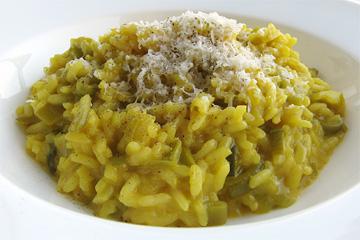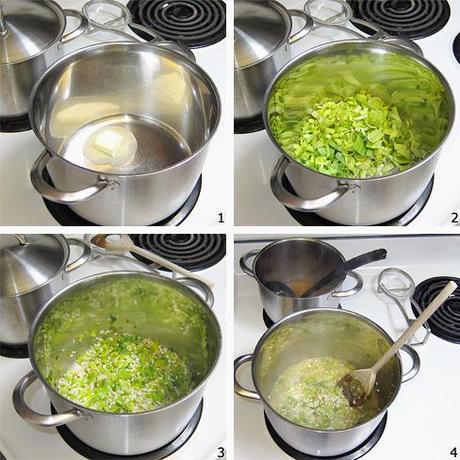 Leeks ('porri', in Italian) have thickening properties and a more complex flavor profile than onions, thanks to the cabbage hints of their upper leaves(1). When replacing onion for leek in a risotto, the resulting dish is creamier and with more depth. Saffron brings an additional element to this first course, and the brighter color makes it even more appetizing. The preparation of any kind of risotto is very reliable, as long as a few tips (below) are kept in mind.
Leeks ('porri', in Italian) have thickening properties and a more complex flavor profile than onions, thanks to the cabbage hints of their upper leaves(1). When replacing onion for leek in a risotto, the resulting dish is creamier and with more depth. Saffron brings an additional element to this first course, and the brighter color makes it even more appetizing. The preparation of any kind of risotto is very reliable, as long as a few tips (below) are kept in mind.Ingredients for 2 people
- ⅔ cups of risotto rice (Carnaroli or Arborio)
- 2 leek stalks, washed and sliced
- 1 ½ tablespoon of butter
- ½ glass of white wine, at room temperature
- 3 cups of flavorful vegetable broth
- ½ of a pouch of Italian saffron
- ¼ cup of Parmigiano, grated
- Black pepper, freshly ground
- Salt

Preparation
- Bring the stock to a gentle boil.
- In a second, larger, pot melt 1 tablespoon of butter (fig. 1).
- Add the leek to the butter (fig. 2) and roast it at medium heat until tender.
- Add the rice and toast it with the leek for 2-3 minutes (fig. 3).
- Add the wine and let it evaporate while stirring constantly. Reset the clock - the rice cooking time will be between 15 minutes (for Arborio) and 18 minutes (for Carnaroli).
- Add the vegetable broth, one ladle at a time, while stirring frequently (fig. 4). Ensure that both the risotto and the broth are kept simmering.
- When the rice is almost ready, dissolve the saffron in one ladle of broth and then add it to the pot. By the time the rice will be ready, the risotto will need to be quite soft, but without any excess liquid left in the pot.
- When the time is up, take the pot off the heat.
- Stir in ½ of the grated Parmigiano and the remaining ½ tablespoon of butter, adjust the salt if necessary.
- Let the risotto rest for 1 minute.
- Serve sprinkled with the rest of the Parmigiano and some ground black pepper.

(1) Harold McGee. On Food and Cooking: The Science and Lore of the Kitchen. 2nd edition (2004).

